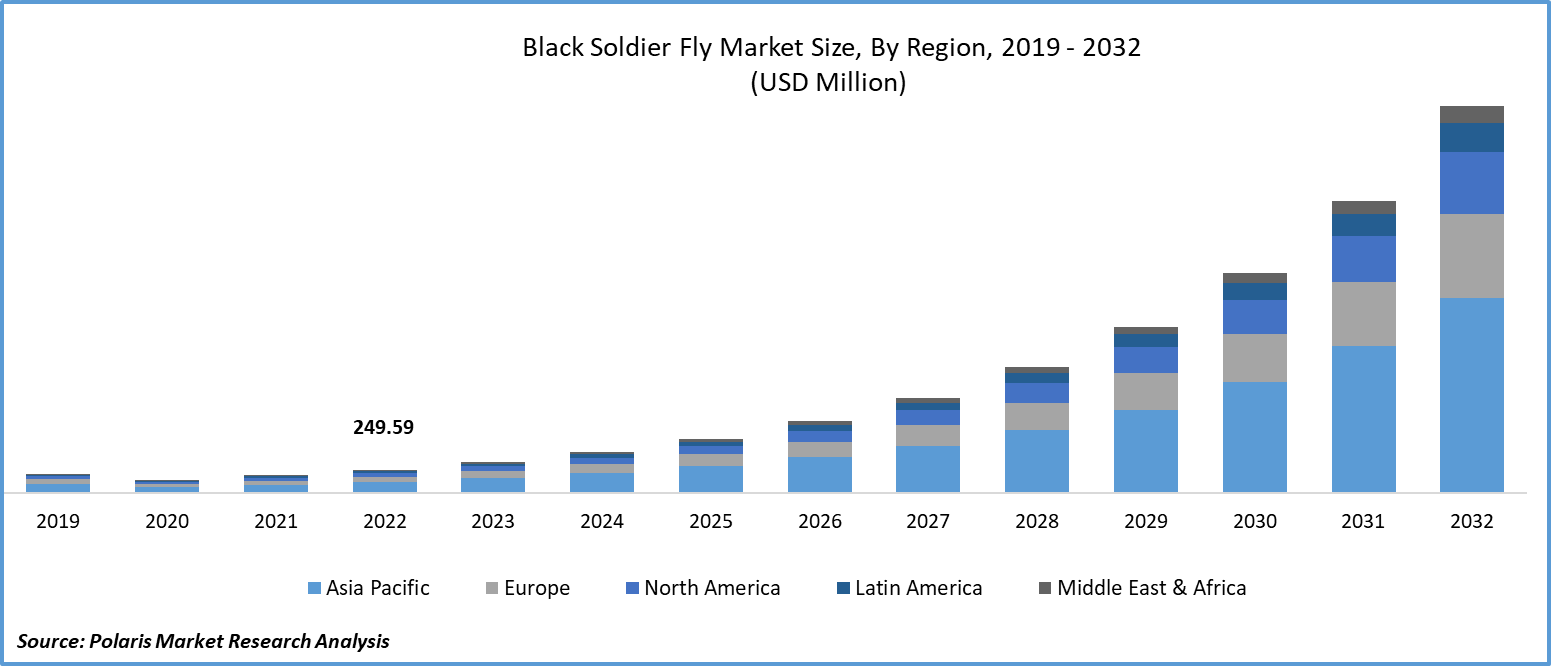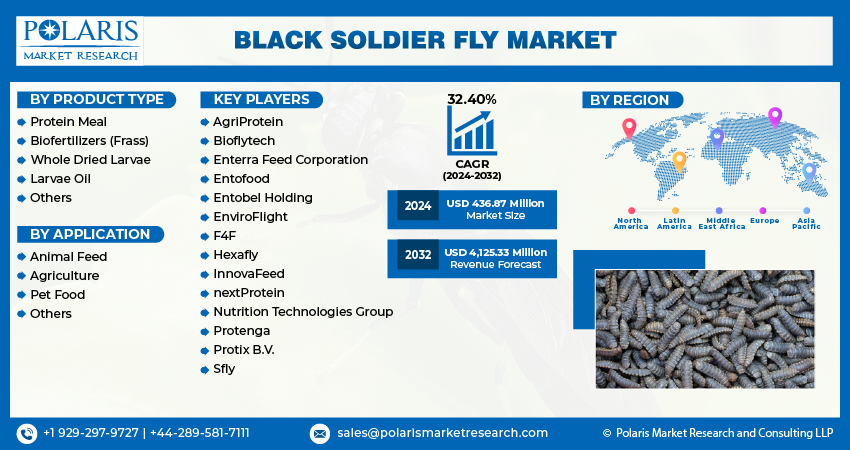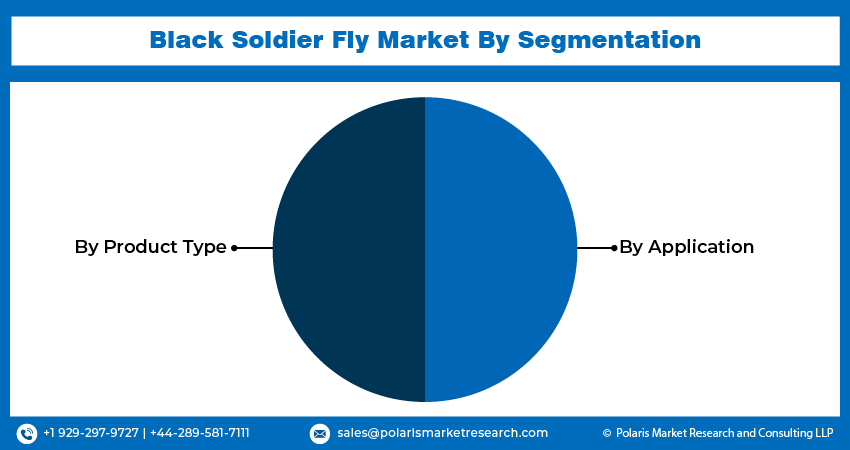
Black Soldier Fly Market Share, Size, Trends, Industry Analysis Report, By Product Type (Protein Meal, Biofertilizers, Whole Dried Larvae, Larvae Oil, Others); By Application; By Region; Segment Forecast, 2024- 2032
- Published Date:Jan-2024
- Pages: 116
- Format: PDF
- Report ID: PM3964
- Base Year: 2023
- Historical Data: 2019-2022
Report Outlook
The global black soldier fly market size and share is projected to witness robust growth. It was valued at USD 330.19 million in 2023 and is projected to grow to USD 4.12 billion By 2032 exhibiting a CAGR of 32.40% the forecast period 2024 – 2032.
Black Soldier Fly (BSF) is gaining traction nowadays in farming, animal feed, and more. BSF farmers use pungent substrates, made from a combination of cattle, pig, and chicken manure, to draw BSF from the wild. They are looking forward to exploring alternative substrates and inexpensive technology. BSF's manufacturing costs per ton are between 50% and 62% less than those of traditional soybean meal. This is driving producers to step into black soldier fly farming to meet animal feed demands. Growing research studies and reviews are showcasing the importance of black soldier flies in the food industry.
Hermetia illucens, or BSF, commonly known as the black soldier fly, is a species that is native to South America. It is now widespread in temperate regions of Europe, the Americas, Asia, and Africa. The mature flies' color is black with metallic reflections, which is the source of the name. They are an excellent source of animal protein for animals and humans alike. When dried, they hold up to 50% of high-quality protein.
Moreover, reducing food waste and encouraging environmentally friendly agriculture are goals that are in line with the effective conversion of organic waste materials into valuable protein and fat by BSF larvae. As such, the circular economy and sustainability serve as major factors for the expansion of the black soldier fly market. Also, these flies are used in waste management, bioremediation, organic fertilizers, and animal feed applications such as aquaculture and poultry. Black soldier flies will be used in sustainable packaging, medications, and cosmetics, according to future studies.

To Understand More About this Research: Request a Free Sample Report
- For instance, in January 2023, a mini-review published in PubMed focused on the sustainable organic waste management tool, the black soldier fly, its effectiveness in converting various bio waste into nutritional content, and examining the byproducts applications.
Moreover, the application of black soldier fly is not only limited to animal feed like poultry and aquaculture but also organic fertilizers, waste management, and bioremediation. Further research is going to use black soldier flies in sustainable packaging, pharmaceuticals, and cosmetics. This will expand the growth of the market in the coming years.
However, the lack of awareness about the benefits associated with the black soldier fly is making it a huge issue for people to enter its farming. This is primarily attributable to people's perceptions about the chance of disease evolution and the development of black soldier fly larvae from waste, restraining production, and demand in the coming years.
The black soldier fly market report is a comprehensive assessment of all the opportunities and challenges in the industry. It covers all the recent innovations and major events in the industry while shedding lights on the key market features such as CAGR, supply/demand, cost, production rate and consumption. Along with that, the study offers a thorough analysis of the key market dynamics and latest trends to help businesses develop strategies that will drive black soldier fly industry growth.

Growth Drivers
- The effectiveness of the black soldier fly in converting solid waste into nutritional animal feed
Research and development activities to increase awareness regarding market are growing day by day. A 2022 study published in Science Direct focused on finding potential challenges, opportunities, and solutions for the black soldier fly. Innovation in protein sources for food and feed for both people and animals is being driven by rising demand for food, as well as the need to feed a population of 9.6 Bn people, by 2050 while also reducing emissions and addressing environmental issues.
Black soldier fly larvae have a remarkable capacity for transforming organic waste, whether it be mixed or separate trash, into biomass that is high in fat and protein and has excellent nutritional potential. A variety of organic wastes, including crop straw, animal dung, municipal organic waste, food waste, and empty fruit bunches, can be ingested by BSFL. According to the study in 2020, although they consume garbage, rotten food, and manure, BSFL cannot spread parasites or diseases when utilized in feed. Food waste treated with insects is an environmentally beneficial method of recycling waste that also has the advantage of having inexpensive installation costs. Its ability to provide a good feed for animals is driving the growth of the market in the coming years.
Report Segmentation
The market is primarily segmented based on product type, applications, and region.
|
By Product Type |
By Application |
By Region |
|
|
|
To Understand the Scope of this Report: Speak to Analyst
By Product Type Analysis
- Protein meal segment is expected to witness the highest growth during the forecast period
The protein segment is expected to grow at a higher rate during the projected period, mainly driven by its effectiveness in providing beneficial feed to animals from waste. Since its larvae are a high source of fat (7–39% dry matter—DM) and protein (37–63% DM) with a better amino acid profile than soybean meal, the black soldier fly has been frequently employed as an element in animal diets. Furthermore, it is a cost-effective option compared to fish meals and soy, driving its demand for animal feed in the coming years.
The biofertilizers (frass) segment witnessed a substantial revenue share in 2022, highly attributable to its capability of improving soil nutritional levels as an organic fertilizer. Rising demand for organic products is driving further demand for organic bio fertilizer like black soldier fly in the coming years to meet ongoing consumer demand by farmers. According to the 2021 study, by improving soil fertility and subsequently vegetable production, black soldier fly frass may offer excellent potential as a beneficial organic bio-fertilizer. This study demonstrates the ability of black soldiers to improve soil fertility, driving its demand by farmers during the study period.
By Application Analysis
- Animal Feed segment accounted for the largest market share in 2022
The animal feed segment accounted for the largest market share. Black soldier fly larvae have become a promising replacement for traditional livestock feed sources due to their nutritional profile and waste-reduction abilities. The Down to Earth report claims that raising poultry is expensive, with feed accounting for up to 70% of total costs. As the world's population rises, traditional chicken feed, which primarily consists of wheat and soy, is becoming scarce, necessitating the use of sustainable alternatives. Due to their low cost, minimal impact on the environment, and natural traits, black soldier fly larvae are a possible feed option for poultry farmers. These larvae are capable of efficiently converting organic waste into priceless vitamins and minerals that can improve the nutrition of poultry.

Regional Insights
- Asia Pacific region registered the largest share in the global market in 2022
The Asia Pacific region witnessed the largest share in 2022 and is expected to continue its market position over the study period. The growing waste in the countries is leading to landfills, where it rots and decomposes, creating methane, a greenhouse gas 23 times more potent than carbon dioxide. This is driving the demand for black soldier fly, as it can convert waste into organic manure and animal feed. A start-up company in India took the initiative to use the waste generated in Dimapur, Nagaland. As companies come forward to produce black soldier flies, the supply in the market will increase, leading to stability in prices.
According to a recent assessment by the NITI Aayog, metropolitan India generates between 130,000 and 150,000 metric tonnes of municipal solid garbage daily, or 330 to 550 grams per person. This amounts to about 50 million MT annually, and if current trends continue, this number might increase to almost 125 million MT annually by 2031. This is driving the governments to act against waste and its future production.
The Europe region is expected to be the fastest-growing region with a healthy CAGR during the projected period, owing to rising consumer interest in sustainable proteins. According to the survey conducted by the Good Food Institute and Opinion Way in 2022, most consumers expressed concern about the environmental effects of traditional animal agriculture, with 60 percent saying alternatives are required in France, Germany, Italy, and Spain, and 71 percent in Italy. This will create new growth opportunities for the black soldier fly market as it is an environmentally sustainable option due to its ability to convert waste into nutritional content for animal feed.

Key Market Players & Competitive Insights
The black soldier fly market is witnessing higher competition in the marketplace owing to the rise in collaboration, partnerships, mergers, and acquisitions among the companies to enhance their market coverage and fuel new product innovations, with technological adoption driving demand for the products in the coming years.
Some of the major players operating in the global market include:
- AgriProtein
- Bioflytech
- Enterra Feed Corporation
- Entofood
- Entobel Holding
- EnviroFlight
- F4F
- Hexafly
- InnovaFeed
- nextProtein
- Nutrition Technologies Group
- Protenga
- Protix B.V.
- Sfly
Recent Developments
- In August 2023, a study published in Animal Frontiers focused on the advantages of black soldier fly to local and small-holder farmers. It reveals the capability of the black soldier fly to provide a significant alternative protein source. It can be grown locally by small- or medium-sized farmers and integrated with the raising of fish on farms.
Black Soldier Fly Market Report Scope
|
Report Attributes |
Details |
|
Market size value in 2024 |
USD 436.87 million |
|
Revenue Forecast in 2032 |
USD 4,125.33 million |
|
CAGR |
32.40% from 2024 – 2032 |
|
Base year |
2023 |
|
Historical data |
2019 – 2022 |
|
Forecast period |
2024 – 2032 |
|
Quantitative units |
Revenue in USD million and CAGR from 2024 to 2032 |
|
Segments Covered |
By Product Type, By Application, By Region |
|
Regional scope |
North America, Europe, Asia Pacific, Latin America, Middle East & Africa |
|
Customization |
Report customization as per your requirements with respect to countries, region and segmentation. |
Seeking a more personalized report that meets your specific business needs? At Polaris Market Research, we’ll customize the research report for you. Our custom research will comprehensively cover business data and information you need to make strategic decisions and stay ahead of the curve.
Navigate through the intricacies of the 2024 black soldier fly market with precision, thanks to the comprehensive statistics on market share, size, and revenue growth rate assembled by Polaris Market Research Industry Reports. This thorough analysis not only provides a glimpse into the historical context but also extends its reach with a market forecast outlook until 2032. Immerse yourself in the richness of this industry analysis by securing a complimentary PDF download of the sample report.
